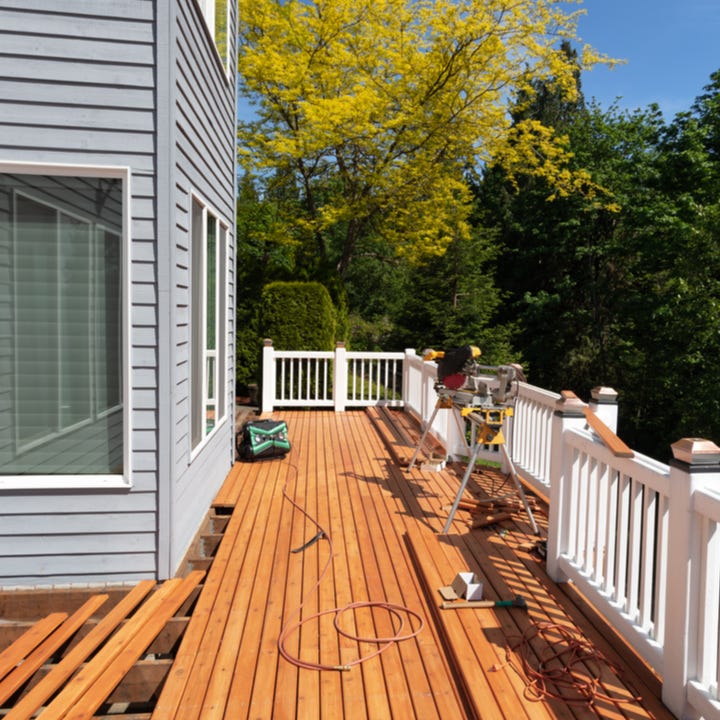Key takeaways
- Home improvement loans provide homeowners with quick funding and flexible repayment options.
- The best home improvement loan rates are reserved for borrowers with good or excellent credit, while rates for borrowers with bad credit can be high.
- Home improvement loans can build your credit and increase the value of your home if managed well, but they have serious drawbacks, like high fees, impacts to your credit and secured options that put your assets at risk.
The average home improvement project costs about $5,600, according to 2025 data collected in 20 metropolitan areas by the Joint Center for Housing Studies. While cash remains a popular way to fund improvements to your home, not every homeowner can afford to tap their savings, especially for larger-than-average projects. Home improvement loans are a type of personal loan available from banks, credit unions and online lenders, and they feature fixed rates and predictable payments.
Flexible and fast, home improvement loans are a great option for some home projects, but they’re not your only option and, depending on your situation, they may not be your best option. Understanding the pros and cons of personal loans for home improvement projects will help you decide how to fund your next project.
Pros and cons of personal loans for home improvement
Home improvement loans can help you get started on projects around your home when you don’t have the cash on hand to cover them. Like any other loan, they need to be managed responsibly, or you could end up damaging your finances and credit score.
Pros
- No collateral or equity required
- Finance projects that add value to your home
- Fixed payments and fast funding
Cons
- Higher rates than secured forms of financing
- Shorter repayment terms and lower loan amounts
- Good credit may be required
Unsecured home improvement loans can be a good fit if you want to finance renovations without putting your home on the line. Since these loans don’t require collateral or home equity, they’re accessible even if you’re a newer homeowner or simply don’t want to tap into your property’s value. You’ll also know exactly what to expect with fixed monthly payments, and funds are often disbursed quickly so you can start your project right away.
That said, unsecured loans do come with trade-offs. Interest rates are usually higher than what you’d find with a home equity loan or HELOC, and loan amounts are generally smaller with shorter repayment terms. That can mean higher monthly payments, which may be tough to fit into your budget. And because lenders often reserve their best rates for borrowers with strong credit, you may need a good credit score to qualify for affordable financing.
Should you use a personal loan for home improvement?
Personal loans are a fast and low-risk way to finance home improvements. But they aren’t always the optimal choice for your situation.
When to get a home improvement personal loan
- You need to cover emergency repairs quickly. Some lenders can approve you for an unsecured personal loan in minutes and may offer same- or next-day funding.
- You don’t want to put up collateral. Most home improvement loans are unsecured, so you won’t risk losing your assets if you fall behind on repayment. (But you will seriously damage your credit if you default on a personal loan.)
- You don’t have much home equity. If you just bought your home or didn’t make a large down payment, you may not have enough equity to make a home equity loan feasible. If that’s the case, an unsecured home improvement loan is a great alternative.
- You’re funding a short-term project with a set budget. Home improvement loans offer a one-time lump sum of funds. If you know exactly how much you need to borrow, a personal loan can help you stick to your budget without borrowing more than is necessary.

The best home improvement loans of 2025
If a personal loan is the right fit for your borrowing needs, compare Bankrate’s top picks for the best home improvement lenders.
Learn more
When not to get a home improvement personal loan
- You have poor credit or other debts. While bad credit loans are available, they come with high rates and unfavorable terms. A low credit score or a high debt-to-income ratio can make it harder to qualify and receive a competitive rate.
- You don’t know how much you need to borrow. A home improvement loan offers a set amount of money. If you need more money than expected, you’ll have to take out another loan or turn to other borrowing options for more money. A credit card or HELOC may offer more flexibility for ongoing projects.
- Your planned renovation will exceed typical loan limits. Most lenders cap personal loan amounts at $50,000, though some excellent-credit borrowers may qualify for up to $100,000 with select lenders. But if you need to borrow more than that, you may need to rely on secured forms of borrowing.
- You have significant home equity. Home equity loans and HELOCs tend to have lower rates than unsecured debt like personal loans. You can typically borrow up to 85 percent of your available home equity. If you have a large amount of equity in your home, you could receive a larger loan at a lower rate with a longer repayment term via home equity financing.
Other ways to finance a home improvement project
A home improvement loan isn’t the only way to finance your home improvement project.
Home equity loan
Like personal loans, a home equity loan is disbursed in a lump sum and repaid in a set of fixed installments. The difference is that home equity loans are secured by your home, resulting in a lower rate. However, this means you could lose your home if you default on the loan. Home equity closing costs can also be high, potentially 2 to 5 percent of the loan amount.
HELOC
A home equity line of credit is a line of revolving credit — similar to a credit card — that you can draw money from as needed. HELOCs come with variable interest rates that fluctuate with the market, but during the introductory draw period (which can last up to 10 years), you may be able to make interest-only payments. Like a home equity loan, a HELOC is secured with your home and can include high closing costs.
Cash-out refinance
With a cash-out refinance, you borrow a new mortgage for more than you owe on your house and use the difference to pay for your home improvement project. Closing costs can be high, and since your new mortgage will have a new interest rate, this option won’t make sense if interest rates are higher than when you originally took out your mortgage.
Title I property improvement loan
A Title I property improvement loan is a government loan guaranteed by the Federal Housing Administration (FHA). It’s designed for home improvements, renovations and repairs. While it’s a good option for homeowners with low-to-moderate incomes, the maximum borrowing amount is $25,000 for a single-family home, which is lower than other borrowing options. Plus, larger loan amounts may be secured by the property, and not all home improvement projects will qualify.
Credit cards
Credit cards can be an expensive way to cover a big purchase because interest rates are usually much higher than other financing options. But if you have great credit, you may qualify for a card with a 0 percent APR introductory period. Depending on the card, the promotional period may be as long as 21 months.
If you’re certain that you’ll be able to pay off your balance before the promotional period ends, a credit card can be an interest-free way to borrow money. But beware: Any balance that remains when the introductory period expires will be subject to interest, and credit card interest rates can be high. (And if you have a card that charges deferred interest, you could be on the hook for all the interest that would have accrued during the promotional period.)
Savings
The cheapest way to cover a home improvement project is by using your savings. You’ll avoid interest and fees, you won’t increase your debt load, and you won’t impact your credit. If you have a home improvement project on the horizon, start a sinking fund to store your savings and help you avoid debt.
Of course, you may not have time to save for an expensive project, or you may not want to deplete your savings if they’re earmarked for another expense. You’ll also miss out on earning interest if you spend your savings.
Bottom line
Any time you borrow, it’s important to consider the impact that taking on debt will have on your financial well-being. Start with a hard look at your finances to decide if now is the right time to complete your project — and if borrowing is the right way to pay for it.
If you decide the time is right, a home improvement loan can be a great borrowing option, although it’s far from your only choice. Be sure that whatever option you choose fits comfortably into your budget and will make repayment easy.
Why we ask for feedback
Your feedback helps us improve our content and services. It takes less than a minute to
complete.
Your responses are anonymous and will only be used for improving our website.
Help us improve our content
Read the full article here














